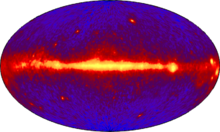Cosmic gamma rays
The electromagnetic radiation in space with an energy higher than approx. 300 keV is called cosmic gamma radiation . Sometimes the X-rays above 1 keV are also added. The highest energies exceed 10 12 eV.
In contrast to the particle radiation of cosmic rays , gamma rays are not deflected by magnetic fields, but radiate almost in a straight line from their point of origin and thus provide information about the direction in which their source is located. Since the earth's atmosphere shields gamma radiation, it is only gamma telescopes in space that make it possible to scan the sky. The research of cosmic gamma rays is the task of gamma astronomy .
Radiation sources
The picture above right shows a survey of the sky taken in 1993 with the Compton Gamma Ray Observatory satellite . The bright band is the Milky Way, with its center in the middle. The Vela-Pulsar PSR 0833-45 stands out to the right of it . Other strong sources of gamma rays in the Milky Way are the pulsar PSR B0531 + 21 in the Crab Nebula and Geminga . The point sources outside the light band are extragalactic sources. For example, the source is assigned to the quasar 3C 279 at the top right .
Other sources: sun , gamma-ray bursts , many pulsars , black hole
Emergence
Brake radiation , synchrotron radiation , inverse Compton effect , spallation , radioactive isotopes (line spectroscopy)
Detection instruments
X-ray satellites have been studying the energy and spatial distribution of cosmic rays since the 1990s . Ground-based telescopes for gamma radiation are z. B. MAGIC on La Palma and HESS in Namibia.
Satellites: INTEGRAL (gamma line spectroscopy), XMM-Newton ...
literature
- CR Kitchin: Astrophysical Techniques. 3rd Ed., IOP Publishing, 1998, ISBN 0-7503-0498-7 .
